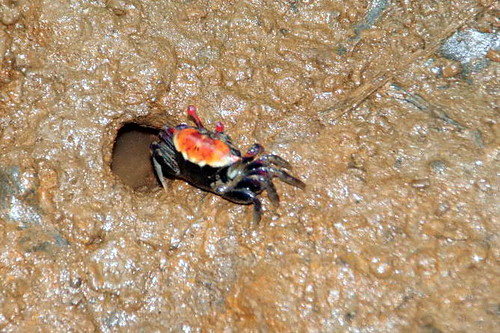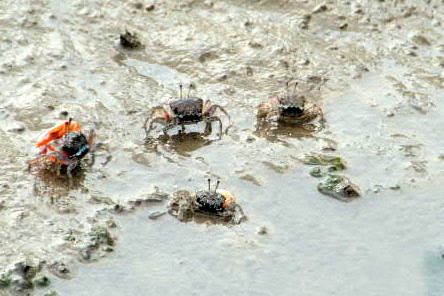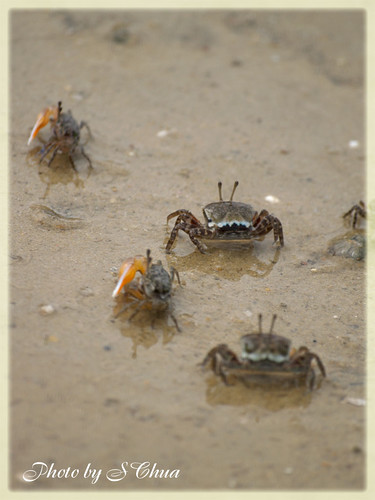Singapore Crabs
True Crabs (Brachyurans)
Superfamily Dromioidea
Family Dromiidae (Burrowing Crabs)
Superfamily Calappoidea
Family Calappidae (Box Crabs)
Family Matutidae (Moon Crabs)
Superfamily Carpilioidea
Family Carpiliidae
Superfamily Corystoidea
Family Corystidae (Masked Burrowing Crabs)
Superfamily Dorippoidea
Family Dorippidae (Sponge Crabs)
Superfamily Eriphioidea
Family Menippidae (Stone Crab)
Family Oziidae (Forceps Crab)
Family Eriphiidae
Superfamily Leucosioidea
Family Leucosiidae (Pebble Crabs)
Superfamily Majoidea (Spider Crabs)
Family Majidae
Family Epialtidae
Family Inachidae (Velcro Crab, etc)
Superfamily Parthenopoidea
Family Parthenopidae (Elbow Crabs)
Superfamily Pilumnoidea
Family Pilumnidae (Hairy Crabs)
Superfamily Portunoidea
Family Portunidae (Swimming Crabs, Flower Crabs, Mud Crabs)
Flower Crabs (Portunus pelagicus) are one of the crabs commonly sold in marketplaces. They have a distinctive "flowery" pattern on their shell. They are a type of Swimming Crab (Family Portunidae), which also includes the Mud Crabs used for chilli and pepper crab.

Moulted shell at Chek Jawa ©Tan KH
Mud Crabs (genus Scylla) are the type of crabs found on our dining table. Fortunately, the local mud crabs are not as large as the Giant mud crab (S. serrata), which is the one commonly used for chilli and pepper crabs. They belong to the family Portunidae (the swimming crabs). Singapore has three species: Orange (S. olivacea), Green (S. paramamosain) and Purple Mud Crab (S. traquebarica). The Orange Mud Crab has orange claws, the Green Mud Crab has green and orange claws, and the Purple Mud Crab has purple claws.
Superfamily Xanthoidea
Family Xanthidae
Superfamily Grapsoidea
Family Grapsidae
Family Plagusiidae
Family Sesarmidae (Sesarmine Crabs, Vinegar Crabs, etc)
Family Sesarmidae includes the tree-climbing crabs, which are commonly seen at Sungei Buloh.
The most easily recognised are the large Vinegar Crabs (Episesarma sp.). The Violet Vinegar Crab (E. versicolor) has pale or violet claws. The Singapore Vinegar Crab (E. singaporense) and Pink-fingered Vinegar Crab (E. chentongense) both have red claws, but the granules on the claws are white in the former and red in the latter. The Pink-and-white-fingered Vinegar Crab (E. palawanense) has a pale dactyl (movable claw) and a red propus (unmovable claw). The Thai Vinegar Crab (E. mederi) has a violet dactyl and a red propus.
Singapore Vinegar Crab (E. singaporense) or Pink-fingered Vinegar Crab (E. chentongense)
Pink-and-white-fingered Vinegar Crab (E. palawanense)
Violet Vinegar Crab (E. versicolor)
Family Varunidae (Paddler Crabs, etc)
Superfamily Ocypodoidea (Stalk-eyed Crabs)
Family Camptandriidae
Family Dotillidae (Soldier Crabs, Sand Bubbler Crabs, etc)
Family Macrophthalmidae (Sentinel Crabs, etc)
Family Ocypodidae (Ghost Crabs and Fiddler Crabs)
Ghost Crabs (Genus Ocypode) belong to the same family (Family Ocypodidae) as the Fiddler Crabs (Genus Uca). They are so called because they are able to disappear quickly into their burrow when threatened. They are found on sandy coasts. Sometimes, they have one claw larger than the other, but the size difference is not as distinct as the fiddler crabs'. There are two species in Singapore - Horn-eyed Ghost Crabs (O. ceratophthalma) and Common Ghost Crab (O. cordimana).
Fiddler Crabs (Genus Uca) belong to the same family (Family Ocypodidae) as the Ghost Crabs (Genus Ocypode). The male is easily recognised by having a claw disproportionately larger than the other. The female has claws of the same size.
Porcelain Fiddler (U. annulipes)
U. dussumieri (probable)
U. forcipata
U. hesperiae (probable)
Rosy Fiddler (U. rosea)
Purple Fiddler (U. paradussumieri)
U. perplexa (probable)
U. rhizophorae
U. tetragonon (probable)
U. triangularis (probable)
Orange Fiddler (U. vocans)
Rosy Fiddler Crab (U. rosea)
Orange Fiddler Crab (U. vocans)


Male Orange Fiddler (U. vocans) at Chek Jawa ©Lau SY. Male and female Orange Fiddler (U. vocans) at Chek Jawa ©Tan KH
References
http://www.fiddlercrab.info/http://mangrove.nus.edu.sg/guidebooks/text/2053.htm
Hermit and Porcelain Crabs (Anomurans)
Family Coenobitidae (Land Hermit Crab)
Family Diogenidae
Hermit Crabs use empty shells as shelters because they have a soft body.
References
http://rmbr.nus.edu.sg/rbz/biblio/s17/s17rbz.pdfhttp://animaldiversity.ummz.umich.edu/site/accounts/classification/Decapoda.html#Decapoda
http://www.wildsingapore.com/wildfacts/crustacea/crustaceaindex.htm

































No comments:
Post a Comment